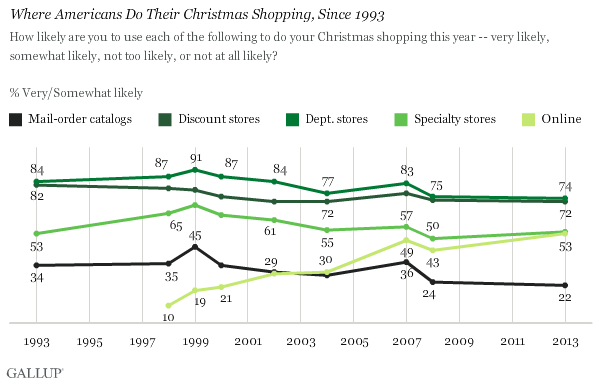PRINCETON, NJ -- As the Christmas shopping season gets underway in earnest this Friday, for the first time, a majority of Americans, 53%, say they are very or somewhat likely to do their Christmas shopping online this year. This is the highest percentage since Gallup first asked the question in 1998. Meanwhile, the percentages of Americans shopping for gifts in department stores and discount stores have been slowly declining, but these still beat the Internet as the places Americans will shop for the holidays.

Online Holiday Shopping Rises While Discount Stores and Catalogs Decline
Based on a Nov. 7-10 Gallup poll, the largest change in Christmas shopping behavior over the past 15 years has been an increase in the percentage of Americans who intend to do their holiday shopping online. In 1998, 10% said they were likely to shop online for Christmas. The 2013 reading of 53% reflects a 43-percentage-point increase in the 15 years since this first poll.
Meanwhile, many other methods of shopping have fallen in popularity. Americans are now less likely to do their holiday shopping in department stores (a 10-point drop since 1993), discount stores (also a 10-point drop), and catalogs (down 12 points).
Online shopping first moved ahead of catalog shopping in 2004, and now matches the percentage likely to shop in specialty stores. But discount stores and department stores, despite the declines, maintain a healthy advantage over online shopping.
Implications
As this year's kickoff to the holiday shopping season approaches, traditional department and discount stores remain the go-to places for Americans when they do their Christmas shopping. However, as more and more of Americans' lives are conducted online, so too is their holiday shopping. In the past two decades, online shopping has become a major player in the holiday retail space. As recent Gallup research has shown, some Americans are now using brick-and-mortar stores as "showrooms," visiting stores to examine products but ultimately making the purchase online.
So it may be years before holiday shopping online surpasses shopping in discount and department stores, but the trend doesn't show signs of stopping.
Survey Methods
Results for this Gallup poll are based on telephone interviews conducted Nov. 7-10, 2013, with a random sample of 1,039 adults, aged 18 and older, living in all 50 U.S. states and the District of Columbia.
For results based on the total sample of national adults, the margin of sampling error is ±4 percentage points at the 95% confidence level.
Interviews are conducted with respondents on landline telephones and cellular phones, with interviews conducted in Spanish for respondents who are primarily Spanish-speaking. Each sample of national adults includes a minimum quota of 50% cellphone respondents and 50% landline respondents, with additional minimum quotas by region. Landline and cell telephone numbers are selected using random-digit-dial methods. Landline respondents are chosen at random within each household on the basis of which member had the most recent birthday.
Samples are weighted to correct for unequal selection probability, nonresponse, and double coverage of landline and cell users in the two sampling frames. They are also weighted to match the national demographics of gender, age, race, Hispanic ethnicity, education, region, population density, and phone status (cellphone only/landline only/both, and cellphone mostly). Demographic weighting targets are based on the March 2012 Current Population Survey figures for the aged 18 and older U.S. population. Phone status targets are based on the July-December 2011 National Health Interview Survey. Population density targets are based on the 2010 census. All reported margins of sampling error include the computed design effects for weighting.
In addition to sampling error, question wording and practical difficulties in conducting surveys can introduce error or bias into the findings of public opinion polls.
View methodology, full question results, and trend data.
For more details on Gallup's polling methodology, visit www.gallup.com.
